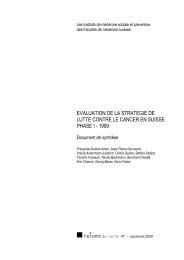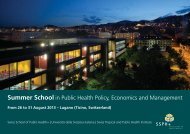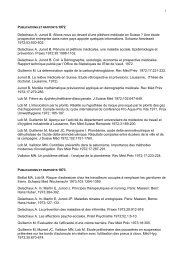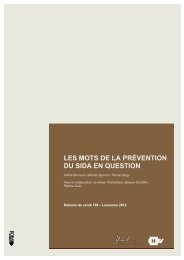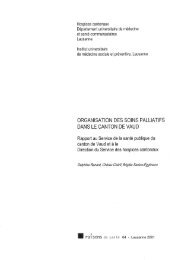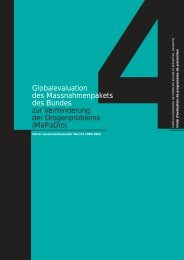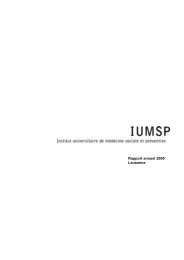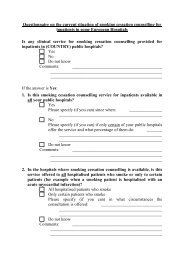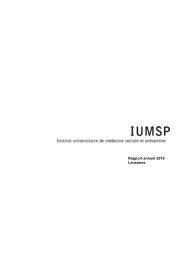Introduction à la statistique médicale : description du cours ... - IUMSP
Introduction à la statistique médicale : description du cours ... - IUMSP
Introduction à la statistique médicale : description du cours ... - IUMSP
You also want an ePaper? Increase the reach of your titles
YUMPU automatically turns print PDFs into web optimized ePapers that Google loves.
<strong>Intro<strong>du</strong>ction</strong> à <strong>la</strong> <strong>statistique</strong> médicale : <strong>description</strong> <strong>du</strong> <strong>cours</strong>1 ère année, 2ème semestre, 10 heures de <strong>cours</strong> + 3 x 2 heures de travaux pratiques, examen obligatoireL’objectif de ce <strong>cours</strong> est d’initier l’étudiant aux concepts et aux méthodes de <strong>la</strong> <strong>statistique</strong> médicale. Le <strong>cours</strong>est p<strong>la</strong>nifié pour une <strong>du</strong>rée de 10 périodes en 5 séances. L’enseignement proposé intègre une partie des objectifs<strong>du</strong> « Catalogue des buts d’enseignement de <strong>la</strong> médecine sociale et préventive au niveau prégra<strong>du</strong>é (14 avril2003) » mais il aborde <strong>la</strong> « méthode <strong>statistique</strong> médicale » d’un point de vue plus général. Les concepts et lesméthodes <strong>statistique</strong>s sont intro<strong>du</strong>its à l’aide de problèmes quantitatifs fondamentaux dans <strong>la</strong> médecine tels que:- L’établissement et utilisation de « normes »- La décision médicale basée sur un test de diagnostic- Les problèmes d’hérédité génétique- Le rôle de l’échantillonnage dans les études d’observation.Chaque thème est traité de façon re<strong>la</strong>tivement complète; toutefois, cette intro<strong>du</strong>ction n’est pas conçue comme un<strong>cours</strong> exhaustif de méthodes <strong>statistique</strong>s. Pour chaque thème, une série d’exercices pratiques est mise àdisposition sur Myunil (voir : lien au Site <strong>du</strong> <strong>cours</strong> de www.iumsp.ch) avec leurs solutions. Les exercices et lessolutions sont discutés dans les séances de travaux pratiques. Les thèmes de ces exercices sont en partie tirés des<strong>cours</strong> de physiologie, radiophysique et de génétique <strong>du</strong> mo<strong>du</strong>le B1.3 (« développement ») en coordination avecles enseignants. Un polycopié <strong>du</strong> <strong>cours</strong> est téléchargeable de Myunil ou de www.iumsp.ch. L’étudiant⋅e estencouragé⋅e à compléter son étude à l’aide de BOMS (Basics of Medical Statistics, projet <strong>du</strong> Campus virtuelsuisse ; www.boms.ch) et à l’approfondir à l’aide <strong>du</strong> « Polycopié de bio<strong>statistique</strong> » téléchargeable surwww.iumsp.ch.A <strong>la</strong> fin <strong>du</strong> <strong>cours</strong> l’étudiant⋅e sera capable de reconnaître les mérites et les faiblesses de <strong>la</strong> méthode <strong>statistique</strong>dans <strong>la</strong> médecine contemporaine (« evidence based medicine »). Il sera capable de réaliser des opérationsquantitatives simples de <strong>la</strong> pratique médicale, comme l’interprétation d’une valeur « anormale » ou le calcul de<strong>la</strong> probabilité qu’un sujet testé positif soit réellement ma<strong>la</strong>de. Il interprétera correctement le concept de test<strong>statistique</strong>.Objectifs détaillés1. Intro<strong>du</strong>ire l’étudiant aux mesures <strong>statistique</strong>s principales (moyenne, écart type, médiane, percentiles) età l’examen, l’interprétation, et l’utilisation de distributions de données. Intro<strong>du</strong>ire l’étudiant au conceptde « modèle mathématique » comme <strong>description</strong> d’une distribution réelle (exemple de <strong>la</strong> distributionnormale).Durée : 4 périodes en 2 séancesApplication : Détermination et utilisation de courbes de croissance et de normes en pédiatrie.Références :BOMS, Chapitres 1, 2, 3, 6Polycopié de bio<strong>statistique</strong>, Chapitres 1, 2, 7www.who.int/childgrowth/standards/en/2. Intro<strong>du</strong>ire les concepts de probabilité, probabilité conjointe, probabilité conditionnelle et leurs re<strong>la</strong>tions.Intro<strong>du</strong>ire le concept d’indépendance entre deux caractères. Etude d’un tableau de fréquences à deuxvoies (fréquences marginales ; fréquences conditionnelles).Durée : 2 périodes en 1 séanceApplication 1: décision médicale basée sur un test de diagnostic (sensibilité, spécificité, taux de fauxnégatifs, valeur prédictive)Application 2 : problèmes simples d’hérédité génétiqueRéférences :BOMS, Chapitre 5Polycopié de bio<strong>statistique</strong>, Chapitres 4, 5
3. Intro<strong>du</strong>ire le concept d’étude d’observation, d’échantillonnage et d’inférence <strong>statistique</strong> de l’échantillonà <strong>la</strong> popu<strong>la</strong>tion. Apprendre à comparer des proportions : le risque re<strong>la</strong>tif, le test <strong>du</strong> chi-carré.Durée : 2 périodes en 1 séanceApplication : étude épidémiologique de <strong>la</strong> re<strong>la</strong>tion entre un facteur antécédent et <strong>la</strong> survenue d’une unema<strong>la</strong>die ; échantillonnage prospectif, rétrospectif, transversal.Références :BOMS, Chapitres 4, 5, 9, 12Polycopié de bio<strong>statistique</strong>, Chapitres 10, 114. Apprendre à comparer les moyennes de deux popu<strong>la</strong>tions à l’aide d’échantillons ; le test de Student.Durée : 2 périodes en 1 séanceApplication : à définir.Références :BOMS, Chapitre 11Polycopié de bio<strong>statistique</strong>, Chapitre 12P<strong>la</strong>n <strong>du</strong> <strong>cours</strong>Des variations <strong>du</strong> p<strong>la</strong>n pourraient être nécessaires pour assurer <strong>la</strong> coordination avec les autres <strong>cours</strong> <strong>du</strong> B1.3.Séance de <strong>cours</strong> no 1: Distributions, Mesures, NormesExemples intro<strong>du</strong>ctifsCourbes de croissance, âge modale au décès, distribution des <strong>du</strong>rées et des coûts de séjour hospitalierConcepts et techniquesPopu<strong>la</strong>tion, échantillonVariables, observationsConcept et représentation de distribution univariéehistogrammes, diagramme en secteurs, fonction cumu<strong>la</strong>tive, box-plotcourbe de survieCaractéristiques principales d’une distribution univariée: symétrie (centre de symétrie), asymétrie,position, étalementConcept de distribution bivariéepour variables binaires (qualitatives) : table 2 x 2pour variables continues (diagramme de dispersion)Séance de <strong>cours</strong> no 2: Distributions, Mesures, NormesConcepts et techniquesMesures numériques de position : moyenne, médiane, percentilesMesures numériques d’étalement : variance, écart type, écart interquartileMesures d’association : risque re<strong>la</strong>tif, coefficient de corré<strong>la</strong>tionConcept de modèle d’une distributionModèle de GaussExemples d’applicationBox-plots de <strong>la</strong> mortalité infantile des cantons suissesLecture et interprétation des courbes de croissance (poids, taille, circonférence crânienne) utilisées enpédiatrie. Que signifie « être dans <strong>la</strong> norme » ?
Séance de <strong>cours</strong> no 3: Eléments de calcul des probabilitésConcepts et techniquesProbabilité conjointeProbabilité conditionnelleRègles fondamentales <strong>du</strong> calcul des probabilitésExemples d’applicationsDécision médicale à l’aide d’un test de diagnostique : sensibilité, spécificité, valeurs prédictives,Combinaison de testsGénétique : problèmes d’hérédité simplesSéance de <strong>cours</strong> no 4: Inférence, partie IConcepts et techniquesComparaison de proportions : formu<strong>la</strong>tion <strong>du</strong> problème, popu<strong>la</strong>tion, échantillon, inférenceCadre théorique <strong>du</strong> test : hypothèses, <strong>statistique</strong> de test, règle de décision, distribution d’échantillonnageTester l’indépendance de deux caractères : test <strong>du</strong> chi carréRisque re<strong>la</strong>tif, intervalle de confiance pour le risque re<strong>la</strong>tifExemples d’applicationsEtudes d’observation en épidémiologie : étude transversale, étude prospective, étude rétrospectiveSéance de <strong>cours</strong> no 5: Inférence, partie IIConcepts et techniquesComparaison d’une moyenne empirique à une valeur théorique : formu<strong>la</strong>tion <strong>du</strong> problèmeComparaison de deux moyennes : formu<strong>la</strong>tion <strong>du</strong> problèmeCadre théorique <strong>du</strong> test de StudentIntervalle de confiance pour une moyenneIntervalle de confiance pour <strong>la</strong> différence entre deux moyennesRe<strong>la</strong>tion entre test et intervalle de confianceExemple d’applicationsAnalyse d’une expérience de radiophysiqueTravaux pratiques no 1Lecture de courbes de croissance (interprétation de percentiles; que signifie « être dans <strong>la</strong> norme »)Travaux pratiques no 2Sensibilité, <strong>la</strong> spécificité et <strong>la</strong> valeur prédictive d'un test de diagnosticProblèmes d’hérédité simplesTravaux pratiques noProblèmes sur <strong>la</strong> comparaison de proportions : test d’adéquation pour un problème de dihybridismeProblèmes sur <strong>la</strong> comparaison de moyennes : analyse d’une expérience de radiophysique
16Comuni del<strong>la</strong> provincia e popo<strong>la</strong>zione residenteGovernance e organizzazioneComuniResidentiComuniResidentiAcquaformosa 1207 Cetraro 10167 Mendicino 9324 Sangineto 1443Acquappesa 1988 Civita 996 Mongrassano 1670Acri 21354 Cleto 1321ComuniMontaltoUffugoResidenti19594Aiello Ca<strong>la</strong>bro 2087 Colosimi 1361 Montegiordano 2042Aieta 845CoriglianoCa<strong>la</strong>bro39824MoranoCa<strong>la</strong>broComuniSan Giovanni inFioreSan LorenzoBellizziSan Lorenzo delValloResidenti1816979434584826 San Lucido 6030Albidona 1551 Cosenza 69611 Mormanno 3424San MarcoArgentano7591Alessandria delCarretto594 Cropa<strong>la</strong>ti 1148 Mottafollone 1360San Martino diFinita1241Altilia 767 Crosia 9184 Nocara 486 San Nico<strong>la</strong> Arcel<strong>la</strong> 1710Altomonte 4666 Diamante 5388 Oriolo 2659Amantea 13968 Dipignano 4488 Orsomarso 1408San Pietro inAmanteaSan Pietro inGuarano5633713Amendo<strong>la</strong>ra 3108 Domanico 1005 Paludi 1218 San Sosti 2194Aprigliano 2776FagnanoCastello4028 Panettieri 346Santa CaterinaAlbanese1339BelmonteCa<strong>la</strong>bro2278FalconaraAlbanese1422 Pao<strong>la</strong> 16926Santa DomenicaTa<strong>la</strong>o1304Belsito 975FiglineVegliaturo1103 Papasidero 891Sant’Agata diEsaro2041BelvedereMarittimo9360 Firmo 2300 Parenti 2316Santa Maria delCedro5089Bianchi 1436FiumefreddoBruzio3205PaternoCa<strong>la</strong>bro1365Santa Sofiad’Epiro2993Bisignano 10462Francavil<strong>la</strong>Marittima2975 Pedace 2046Santo Stefano diRogliano1585Bocchigliero 1620 Frascineto 2328 Pedivigliano 910San Vincenzo LaCosta2174Bonifati 3194 Fuscaldo 8348 Piane Crati 1458 Saracena 4160Buonvicino 2410 Grimaldi 1809 Pietrafitta 1423 Sca<strong>la</strong> Coeli 1202
1.3. Interventions1.3.1 The Swiss healthcare system1.3.1.1 Organization and responsibilities1 Definition of the term healthcare system. 12 Responsibilities of the state at federal, cantonal and municipal levels: surveil<strong>la</strong>nce, 1health promotion, and disease prevention; e<strong>du</strong>cation, occupations and research. Roleof non-governmental organizations (self-help groups, disease-specific organizations,Red Cross).3 Responsibilities and organization of health care providers: out-patient care (doctors, 1midwives and nurses in private practice, managed care group practices, pharmacists,Spitex services); providers of care in public and private hospitals, hospital out-patientclinics and nursing homes.1.3.1.2 Costs, benefits and financing of the health service1 International comparisons of different types of healthcare systems. 12 Funding of healthcare in Switzer<strong>la</strong>nd: funders (the state, social insurance, out of pocket 2payments); sources of costs (out-patient and in-patient health care providers,medicines). Trends and determinants of health care spending.3 Models of reimbursement for health care provision: fee-for-service, fee-per-case, 1prospective or retrospective lump sum payments, HMO model (principle of capitation).Fundamentals of the Tarmed system.4 Costs and benefits of interventions: direct, indirect and intangible costs. 11.3.2 Prevention and health promotion1.3.2.1 Intervention strategies1 Popu<strong>la</strong>tion-based public health strategies: general principles, appropriate setting of 1priorities, feasibility, evaluation.2 Popu<strong>la</strong>tion-based primary prevention: general principles, mass campaigns and targeted 1interventions, structural and indivi<strong>du</strong>al-based strategies.3 Secondary prevention: general principles, screening programs, criteria for assessing 1the appropriateness of screening, current recommendations for screening.4 Principles of primary and secondary prevention in primary health care, opportunistic 1screening.5 Ethical issues re<strong>la</strong>ted to public health interventions (for example screening),1prioritization and equity in health care.1.3.2.2 Risk factors, resources and primary prevention1 Salutogenesis: important behavior-re<strong>la</strong>ted (exercise, nutrition, re<strong>la</strong>xation, safer sex) and 1psychosocial resources (health competence, coping, sense of coherence, socialsupport).2 Pathogenesis: important behavior-re<strong>la</strong>ted risk factors (smoking, alcohol, obesity) and 1psychosocial burdens (stress, critical life events).3 Lifestyle and health behavior: role of cultural influences and the social environment. 14 Counseling of indivi<strong>du</strong>als: model of behavior change; stages of change, stageappropriate2advice.5 Epidemiology, preventive recommendations and approaches to intervention regarding 2exercise, nutrition, alcohol consumption, smoking and sexual behavior.6 Health promotion: Ottawa Charta (levels of action, strategies), health promotion in 1defined settings (for example schools, communities, workp<strong>la</strong>ces, hospitals).7 Prevention and health promotion: important institutions and programs in Switzer<strong>la</strong>nd 1(national health goals, p<strong>la</strong>ns of action of Federal Office of Public Health, nationalcampaigns); opportunities and barriers; considerations at the political level.1.3.3 Chronic and degenerative diseases, accidents1 Epidemiology (prevalence, incidence, mortality, years of life lost) in Switzer<strong>la</strong>nd, 1international comparisons, and strategies for the prevention of: cardiovascu<strong>la</strong>rdiseases, diabetes, cancer (lung, breast, colon, prostate, me<strong>la</strong>noma), musculoskeletaldiseases, respiratory diseases and allergies, mental health problems, addiction,accidents.2 Life <strong>cours</strong>e approach to health: specific risks, health problems and preventivemeasures for children, adolescents and young a<strong>du</strong>lts, middle-aged a<strong>du</strong>lts and theelderly.12
1.3.4 Environmental medicine1.3.4.1 Methodological aspects1 Estimating human exposure to environmental pollution (methods of measuring,semiquantitative proce<strong>du</strong>res, indicators, dosage and safety limits).2 Evaluating health risks <strong>du</strong>e to environmental factors from the point of view of theindivi<strong>du</strong>al and of society as a whole.1.3.4.2 Physical, chemical and radiological hazards1 Sources, trends, distribution and health consequences of: outdoor air pollutants(particu<strong>la</strong>te matter, ozone, nitrogen dioxide); indoor air pollutants (passive smoking,radon, asbestos, formaldehyde, solvents and mould); non-ionizing and ultravioletradiation; ionizing radiation; noise pollution; water- and soil-pollutants (nitrates, heavymetals, pro<strong>du</strong>ction and quality of drinking water in Switzer<strong>la</strong>nd).2 Sources, trends, distribution and health consequences of greenhouse gases andclimate change.1.3.5 International health1 International priorities for health and health care: UN Millennium Development Goals;strengthening health systems; Global Fund to fight for AIDS, TB and Ma<strong>la</strong>ria; essentialhealth interventions; primary health care for all.2 Major causes of disease and death in infancy and the neonatal period, under-5s, a<strong>du</strong>ltsin different parts of the world.3 Determinants of international differences in health: poverty, hunger, popu<strong>la</strong>tion growth,e<strong>du</strong>cation, differences in income, gender differences, environment, conflicts, access tomedical resources.2 Infectious diseases (10 Items)2.1 Basic terms and concepts1 Important definitions and concepts: virulence, resistance, pathogenicity, transmissibility;contamination, colonization, infection, carrier; incubation period, <strong>la</strong>tent period, infectiousperiod; exposure, primary and secondary attack rate, repro<strong>du</strong>ctive number (R o ), herdimmunity; endemic, epidemic, pandemic, sporadic case, outbreak; surveil<strong>la</strong>nce,notification; zoonosis, reservoir, vector, vehicle; chemoprophy<strong>la</strong>xis, immunization,vaccination, active immunization, passive immunization; emerging and re-emerginginfections.2 Laws: international health regu<strong>la</strong>tions; paragraphs in the Swiss constitution (Article 69, 169bis); <strong>la</strong>w on epidemic diseases (Epidemiengesetz/Loi sur les épidémies), notificationregu<strong>la</strong>tions (Meldeverordnung/Ordonnance sur <strong>la</strong> déc<strong>la</strong>ration).3 Epidemiological surveil<strong>la</strong>nce: national and international notification requirements (who 1reports what, when, and to whom); the Sentinel<strong>la</strong> network; advantages anddisadvantages of different surveil<strong>la</strong>nce systems.4 Steps in the recognition, investigation and control of outbreaks. 12.2 Epidemiology and prevention1 Epidemiology (incidence, prevalence, mortality and years of life lost, route of1transmission, risk factors) in Switzer<strong>la</strong>nd, international comparison, and strategies forthe prevention of major infectious diseases: food-borne infections; vaccine preventableinfections; nosocomial infections; HIV and sexually transmitted infections; zoonoses;travel-re<strong>la</strong>ted infections (travelers’ diarrhea, ma<strong>la</strong>ria, amebiasis, hepatitis, yellow fever,rabies, Dengue fever, typhoid fever, tuberculosis, legionnaire’s disease, cholera, HIVand sexually transmitted infections); healthcare-re<strong>la</strong>ted infections (hepatitis, HIV,tuberculosis, influenza, varicel<strong>la</strong>, parvoviruses).2.3 Preventive strategies1 Vaccination (characteristics, indications, contraindications, side-effects, storage, meansof delivery and usage of vaccines for routine administration and specific indications):viral: poliomyelitis, MMR, hepatitis A, hepatitis B, influenza, varicel<strong>la</strong>, tick-borneencephalitis; bacterial: tetanus, diphtheria, pertussis, hemophilus influenzae B,meningococcus C, BCG, typhoid fever, pneumococcal infection.22 Benefits and risks of vaccination: vaccine efficacy, vaccination coverage, vaccinationcampaigns, vaccination failure, adverse events, cost-effectiveness.1111111213
3 Chemoprophy<strong>la</strong>xis (recommended medications, contraindications and indications) for: 1meningococcal meningitis, tuberculosis, endocarditis, ma<strong>la</strong>ria, toxop<strong>la</strong>smosis,pneumocystis jiroveci (carinii)-pneumonia in the immune-suppressed, pre- and postexposureprophy<strong>la</strong>xis of HIV infection; principles and indications for chemoprophy<strong>la</strong>xisin indivi<strong>du</strong>als and <strong>du</strong>ring epidemics.4 General preventive measures in hospitals: hand washing, asepsis, sterilization,2disinfection, iso<strong>la</strong>tion; specific precautions for specific risk proce<strong>du</strong>res (surgicalinterventions, urinary catheters, intravascu<strong>la</strong>r catheters, endoscopy).5 Other measures: border medical examinations and mass screening, needle exchange 1programs, testing of drinking water, prohibition to work in an occupation (for examplehandling food).3 Occupational medicine (11 Items)3.1 Basic terms and concepts1 Important definitions and concepts: occupational medicine, occupational disease, 1occupation-re<strong>la</strong>ted illnesses. Occupational safety limits of the Swiss Accident InsuranceFund (SUVA).2 Steps in the investigation of a suspected occupation-re<strong>la</strong>ted health problem in an 2indivi<strong>du</strong>al or a group.3 Regu<strong>la</strong>tions for health protection and promotion in the occupational and accident 2insurance <strong>la</strong>w (UVG/LAA).4 Principles of primary, secondary and tertiary prevention in the workp<strong>la</strong>ce. 13.2 Occupational diseases1 Occupational workp<strong>la</strong>ce history-taking, and important work-p<strong>la</strong>ce hazards (noise, 2electromagnetic fields, vibration, lead, mercury, solvents, carbon monoxide, aromaticamines, asbestos, wood <strong>du</strong>st, benzene).3.3 Work and health1 Ergonomics: workp<strong>la</strong>ce <strong>la</strong>yout and environmental influences, including working at acomputer terminal, in an open-p<strong>la</strong>n office, person-machine interactions.22 Psychosocial factors and stress, including conditions of work, new work forms, bullying,burnout, unemployment, stress-associated diseases.3 Health-promoting organization of the workp<strong>la</strong>ce: work tasks and organization, includingworking in groups, working time, regu<strong>la</strong>tion of coffee and lunch breaks.4 Company health management: absence (determining and maintaining the ability towork), addiction, health promotion.5 Epidemiology of: accidents in the p<strong>la</strong>ce of work for specific occupations in Switzer<strong>la</strong>nd; 1major work-re<strong>la</strong>ted diseases, recognized by the accident insurance <strong>la</strong>w (UVG/LAA), indifferent occupations.6Epidemiology and health and social consequences of shift- and night-work, work <strong>du</strong>ring 1pregnancy, part-time work.4. Insurance medicine (21 Items)4.1. Basic terms and concepts1 Insurance medicine-re<strong>la</strong>ted <strong>du</strong>ties of treating physicians; independent medical2examiners, training opportunities.2 Liability principles: finality principle, causality principle. 14.2 Social insurance1 General aims and characteristics of social insurance. 22 Overview of the Swiss social insurance system. 23 Funding sources in the Swiss social insurance system: insurance payments, sa<strong>la</strong>ry 2de<strong>du</strong>ctions, franchises, costs carried by the patient, subventions.4 Definitions in the general section of the social insurance regu<strong>la</strong>tions (ATSG/LPGA): 2sickness, accidents, inability to work, incapacity to work, disability, helplessness,subsidiarity principle.5 Definitions of the Swiss accident insurance <strong>la</strong>w (UVG/LAA): accident-like bodily2damage, occupational disease.6 Health insurance <strong>la</strong>w (KVG/LAMal): insured persons, benefits (including positive list of 2preventive measures).7 Accident insurance <strong>la</strong>w (UVG/LAA): insured persons, SUVA and other insuranceproviders, benefits, including integrity benefits.11114
8 Occupational diseases: insured persons, list of occupational diseases recognized by 1UVG / LAA9 Disability insurance (IVG/LAI): insured persons, benefits, including re-integration 1measures, special training and auxiliary equipment.10 Prevention, medical checkups and health promotion (KVG/LAMal). 111 Criteria of effectiveness, appropriateness and efficiency of medical measures1(WZW/EAE) as required by KVG/LAMal.12 Managed care: forms of provision and insurance pro<strong>du</strong>cts (HMO systems, general 1practitioner networks, gatekeeping).13 Instruments for treatment management: case management, disease management, 1demand management.4.3 Legal aspects of working as a physician1 Physicians' obligations: to treat, to protect confidential data, to report and to give 1information (if appropriate).2 Determination of the degree of incapacity to work. 23 Administration of justice in the area of social insurance (ATSG/LPGA). 14 Requirements for informed consent of patients. 25 Principles of physicians' liability (malpractice). 15



